Peter Baker, Laser Institute of America
As just about everyone knows, American physicist Theodore Maiman fired the first laser in May 1960 in Malibu, Calif. What is less well-known is that, in February 1968, also in California, Maiman and other laser pioneers founded the Laser Industry Association to advocate for these endlessly fascinating tools. That group would become the Laser Institute of America (LIA) in 1972.
What began as a modest venture by the late publisher William Bushor has grown into the industry’s leading voice for furthering the reach of lasers and their safe use. Bushor and LIA’s first president, Arthur Lubin, recruited LIA’s first board of directors, which included Maiman, Stanford University professor Arthur L. Schawlow and 10 other visionaries.
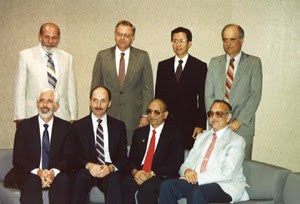
Early leaders of the Laser Institute of America gather in Orlando, Fla., in 1989. Top row, left to right: Bob Goldstein (1984 president), Warren Stevenson (1989), Milton M.T. Chang (1985), Fred Burns. Bottom row: Peter Baker (1987), Michael Bass (1988), Prem Batra and Sid Charschan (1980). All are LIA Fellows, and all except Fred Burns and Prem Batra are LIA past presidents.
LIA’s original directors were an august group, and their devotion to the power and potential of lasers set the tone that guides the organization to this day. Consider Schawlow, who went on to win the 1981 Nobel Prize in physics for laser spectroscopy. His playful demonstrations – putting a blue balloon inside a clear one and firing a laser to pop the balloon inside, or his efforts to create a laser out of Jell-O – led to our understanding of laser absorption and to innovations such as the distributed feedback laser.
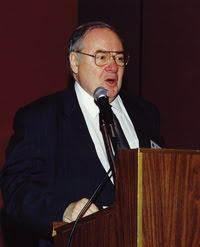
Stanford University professor Arthur L. Schawlow, speaking to a group in Orlando, Fla., in 1989, was one of the first members of LIA’s board of directors.
Gordon Gould, LIA’s third president, coined the term “laser” (light amplification by stimulated emission of radiation) and battled for decades to secure the patents for the inventions that led to his induction into the National Inventors Hall of Fame.
Springing from that lineage, LIA continues its mission “to foster lasers, laser applications and laser safety worldwide.”
LIA’s purpose
As executive director of LIA since 1988, I have marveled at the organization’s growth and expanding reach. I believe in offering our best contributions as good citizens of the world to further sustainable energy, manufacturing efficiency and user safety. Our purpose remains consistent across all the courses, workshops and conferences that we have created or co-sponsored, as well as the publications we offer. LIA’s founders delineated its primary purposes as:
• To disseminate laser-related information and data in publications and symposia.
• To promote, conduct and sponsor/co-sponsor events related to laser subjects.
• To develop and present short courses, programs and curricula for training.
• To act as a focal point for collecting and disseminating data, inquiries and statistics regarding the laser community with regards to applications, safety, research and development.
• To act as a liaison with other organizations in the advancement of laser technology.
• To assist federal and state government agencies to enact legislation relating to the safety of laser products.
Meeting all those goals is a tall order. Sweating the details while simultaneously focusing on big-picture ideals and broad strokes is never easy, especially when trying to maintain the level of excellence LIA expects, and when faced with enormous obstacles such as the “great recession.” But if our organization’s pioneering founders taught us anything, it’s that we continue our work because of our passion for progress in the face of the inevitable hurdles.
LIA prides itself on its reputation as a recognized and trusted global organization. It was former President David A. Belforte’s initiative to establish a US-Japan conference on industrial laser applications that led LIA to create the International Congress on Applications of Lasers and Electro-Optics (ICALEO). This industry-leading show is nearly 30 years old and continues to bring the best and brightest minds together to create the future of laser applications.
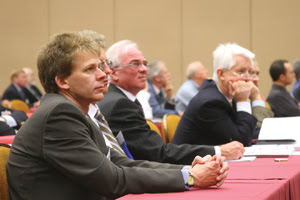
Attendees of the 2008 International Congress on Applications of Lasers and Electro-Optics in Temecula, Calif., listen to a talk.
We have since added the Pacific International Conference on Applications of Lasers and Optics, or PICALO, and the International Laser Safety Conference. Furthermore, we’re holding our second annual Laser Additive Manufacturing Workshop, and we co-own the Automotive Laser Applications Workshop with the Fabricators and Manufacturers Association International. We also collaborate with Laser Zentrum Hannover and the Laser Processing Committee of the Chinese Optical Society on a China-specific laser-processes conference.
Among the many and varied societies and organizations with which we cooperate are the Association of Perioperative Registered Nurses, the American Welding Society and the Academy of Laser Dentistry.
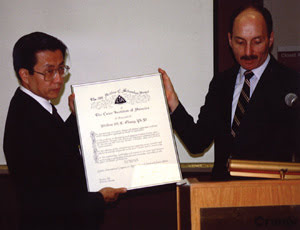
Milton M.T. Chang receives the Schawlow award from Michael Bass in Orlando, Fla., in 1989.
One of LIA’s proudest moments was signing up to work with the Occupational Safety and Health Administration (OSHA) as a partner in the OSHA Alliance to foster safer workplaces. We have trained many OSHA inspectors so that they know how to be effective when they visit establishments where lasers are being used.
On a smaller scale, we have shared information with the FDA regarding lasers and radiological health and have written a brief to help Texas lawmakers revamp their safety regulations. We offer a virtual avalanche of programs for safety officers in medicine, research and industry, ranging from a one-day safety overview to a five-day training course. Of course, LIA also makes its expertise available in online safety courses, and this year it has produced a laser-safety DVD called Mastering Light, which helps safety officers teach their own people.
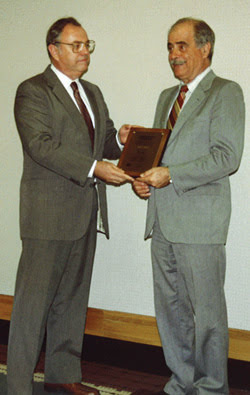
Treasurer Fred Burns receives a Fellow plaque from President Warren Stevenson in Orlando, Fla., in 1989.
Meanwhile, our publications run the gamut from the LIA Today newsletter to a comprehensive series of American National Standards Institute (ANSI) Z136 laser-safety standards. LIA has been publishing the peer-reviewed Journal of Laser Applications for more than 20 years and also spreads its message via Laser Systems Europe, in partnership with the publishing company Europa Science Ltd.
LIA’s future
It has been my hard-won experience that advances in laser technology can take much longer than anticipated to achieve widespread acceptance. I have witnessed firsthand the lag time in adoption of innovations such as laser marking and resistor trimming. Applications I thought would be adopted within five years often took 15 or 20 to become widespread.
Perseverance pays off, however. Look at where we are today: Lasers are everywhere, performing indispensable functions in shipbuilding, medical devices, photovoltaics, and the automotive and aerospace industries. A new generation of researchers doggedly pursues further innovations as we seek alternative energy sources and more efficient, cost-effective manufacturing processes.
Companies such as Trumpf Inc. and IPG Photonics Corp. are pushing the boundaries of what lasers can do. The excellent beam quality, reliability, versatility, power and efficiency of today’s lasers have opened up new areas of application.
As we work to help our industry achieve its true potential in the 21st century, I am guided by a principle that former President Bill Clinton discussed in an interview with Newsweek. While maintaining the view that we are globally interdependent, he said that he frames his decisions and approaches on whether the issues confronting him create positive – or decrease negative – interdependence.
In 1960, the only laser was right here in Malibu. We had the whole market and all the knowledge. Now, lasers are made and applied worldwide. It is incumbent upon the LIA, our members and our partners to understand mutual needs and goals – to create positive or decrease negative interdependence – as we work to fulfill the promise that laser technology offers.
Meet the author
Peter Baker has been the executive director of the Laser Institute of America for 21 years. He has been involved with lasers and applications since 1967 and designed his first laser in 1970. He has served in various senior management roles in the laser industry, including as president and CEO; e-mail: [email protected].